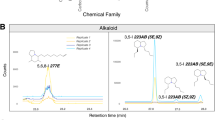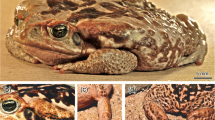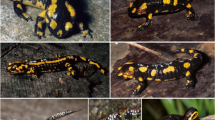Abstract
Frogs in the genus Phyllobates are known for the presence of batrachotoxin, a highly toxic alkaloid, in their skin. Nevertheless, Phyllobates frogs from Costa Rica and Panama (P. lugubris and P. vittatus) are considered non-toxic, as they have been reported to harbor low concentrations of this alkaloid. However, the potential toxicity of Central American Phyllobates has not been assessed experimentally. Our goal was to determine the toxicity of the whole skin of P. vittatus, an endemic species from the Southeastern Pacific region of Costa Rica. We performed median lethal dose (LD50) tests in mice to determine general toxicity, and an irritant assay based on the behavioral responses of mice to subcutaneous injection, to determine differences in irritability, as a measure of toxicity, among three study localities. Using UPLC-ESI-QTOF, we obtained chemical profiles of the methanolic extract of frog skins. Due to the absence of mortality at the studied doses, we were unable to estimate LD50. However, we recorded a list of toxicity symptoms in mice that are consistent with cardiotoxic effects, and found that mice presented more symptoms at higher concentrations of skin extracts during the first hour of the LD50 assays, recovering completely at all doses by the end of the assay. On the other hand, we did not detect differences in irritability among studied localities. Additionally, we putatively identified three toxic alkaloids (Batrachotoxinin A, DHQ 251A and Lehm 275A). This study provides the first experimental data on the toxicity and associated symptoms in mice, as well as the chemical profile of the skin of P. vittatus. We suggest that the skin alkaloids of P. vitattus may confer a chemical defense towards predators.




Similar content being viewed by others
References
Alboukadel K, Marcin K, Przemyslaw B (2019) Survminer: drawing survival curves using 'ggplot2'. R package version 0.4.6. https://CRAN.R-project.org/package=survminer
Albuquerque EX, Daly JW, Witkop B (1971) Batrachotoxin: chemistry and pharmacology. Science 172:995–1002. https://doi.org/10.1126/science.172.3987.995
Amézquita A, Ramos Ó, González MC, Rodríguez C, Medina I, Simões PI, Lima AP (2017) Conspicuousness, color resemblance, and toxicity in geographically diverging mimicry: the pan-Amazonian frog Allobates femoralis. Evolution 71:1039–1050. https://doi.org/10.1111/evo.13170
Berenbaum MR (1995) The chemistry of defense: theory and practice. P Natl Acad Sci 92(1):2–8. https://doi.org/10.1073/pnas.92.1.2
Bolton SK, Dickerson K, Saporito RA (2017) Variable alkaloid defense in the dendrobatid poison frog (Oophaga pumilio) are perceived as differences in palatability to arthropods. J Chem Ecol 43:273–289. https://doi.org/10.1007/s10886-017-0827-y
Broccardo M, Erspamer V, Falconieri Erspamer G, Improta G, Linari G, Melchiorri P, Montecucchi PC (1981) Pharmacological data on dermorphins, a new class of potent opioid peptides from amphibian skin. Br J Parmac 73:625–631. https://doi.org/10.1111/j.1476-5381.1981.tb16797.x
Campos ADS, Diaz BL, Rivera, EAB, Granjeiro, JM, Braga LMGDM, Frajblat M, Stephano MA (2016) Guia brasileiro de produção, manutenção ou utilização de animais em atividades de ensino ou pesquisa científica: fascículo 6. Ministério da Ciência, Tecnologia e Inovação
Close B, Banister K, Baumans V et al (1997) Recommendations for euthanasia of experimental animals: part 2. DGXT of the European Commission. Lab Anim 30:1–2
Daly JW (1995) The chemistry of poisons in amphibian skin. P Natl Acad Sci 92:9–13. https://doi.org/10.1073/pnas.92.1.9
Daly JW, Spande TF (1986) Amphibian alkaloids: chemistry, pharmacology, and biology. In: Pelletier SW (ed) Alkaloids: chemical and biological perspectives. Wiley, New York, pp 1–274
Daly JW, Brown GB, Mensah-Dwumah M, Myers CW (1978). Classification of skin alkaloids from neotropical poison-dart frogs (Dendrobatidae). Toxicon 16(2):163–188
Daly JW, Myers CW, Warnick JE, Albuquerque EX (1980) Levels of batrachotoxin and lack of sensitivity to its action in poison-dart frogs (Phyllobates). Science 208:1383–1385. https://doi.org/10.1126/science.6246586
Daly JW, Myers CW, Whittaker N (1987) Further classification of skin alkaloids from neotropical poison frogs (Dendrobatidae), with a general survey of toxic/noxious substances in the amphibia. Toxicon 25:1023–1095. https://doi.org/10.1016/0041-0101(87)90265-0
Daly JW, Garraffo HM, Spande TF, Clark VC, Ma J, Ziffer H, Cover JF (2003) Evidence for an enantioselective pumiliotoxin 7-hydroxylase in dendrobatid poison frogs of the genus Dendrobates. P Natl Acad Sci 100:11092–11097. https://doi.org/10.1073/pnas.1834430100
Daly JW, Spande TF, Garraffo HM (2005) Alkaloids from amphibian skin: a tabulation of over eight-hundred compounds. J Nat Prod 68:1556–1575. https://doi.org/10.1021/np0580560
Darst CR, Cummings ME (2006) Predator learning favours mimicry of a less-toxic model in poison frogs. Nature 440:208–211. https://doi.org/10.1038/nature04297
Darst CR, Cummings ME, Cannatella DC (2006) A mechanism for diversity in warning signals: conspicuousness versus toxicity in poison frogs. P Natl Acad Sci 103:5852–5857. https://doi.org/10.1073/pnas.0600625103
Dumbacher JP, Beehler BM, Spande TF, Garraffo HM, Daly JW (1992) Homobatrachotoxin in the genus Pitohui: chemical defense in birds? Science 258:799–801. https://doi.org/10.1126/science.1439786
Dumbacher JP, Spande TF, Daly JW (2000) Batrachotoxin alkaloids from passerine birds: a second toxic bird genus (Ifrita kowaldi) from New Guinea. P Natl Acad Sci 97:12970–12975. https://doi.org/10.1073/pnas.200346897
Dumbacher JP, Wako A, Derrickson SR, Samuelson A, Spande TF, Daly JW (2004) Melyrid beetles (Choresine): a putative source for the batrachotoxin alkaloids found in poison-dart frogs and toxic passerine birds. P Natl Acad Sci USA 101:15857–15860. https://doi.org/10.1073/pnas.0407197101
Endler JA, Mappes J (2004) Predator mixes and the conspicuousness of aposematic signals. Am Nat 163:532–547. https://doi.org/10.1086/382662
Erspamer V (1994) Bioactive secretions of the amphibian integument. In: Heatwole H, Barthalmus GT (eds), Amphibian biology. The integument. Surrey Beatty and Sons, pp 178–350
Fox J, Weisberg S (2011) An R companion to applied regression, 2nd edn. Sage, Thousand Oaks
Hovey KJ, Seiter EM, Johnson EE, Saporito RA (2018) Sequestered alkaloid defenses in the dendrobatid poison frog Oophaga pumilio provide variable protection from microbial pathogens. J Chem Ecol 44(3):312–325
Hutchinson DA, Mori A, Savitzky AH, Burghardt GM, Wu X, Meinwald J, Schroeder FC (2007) Dietary sequestration of defensive steroids in nuchal glands of the Asian snake Rhabdophis tigrinus. P Natl Acad Sci 104(7):2265–2270. https://doi.org/10.1073/pnas.0610785104
IUCN, SSC Amphibian Specialist Group, NatureServe (2013) Phyllobates vittatus. The IUCN Red List of Threatened Species 2013:e.T55265A3026493. https://doi.org/10.2305/IUCN.UK.2013-2.RLTS.T55265A3026493.en
Jeckel AM, Grant T, Saporito RA (2015) Sequestered and synthesized chemical defenses in the poison frog Melanophryniscus moreirae. J Chem Ecol 41:205–521. https://doi.org/10.1007/s10886-015-0578-6
Kreil G, Barra D, Simmaco M, Erspamer V, Falconierie-Erspamer G, Negri L, Severini C, Corsi R, Merchiorri P (1989) Deltorphin, a novel amphibian skin peptide with high selectivity and affinity for δ opiodid receptors. Eur J Pharmacol 162(1):123–128. https://doi.org/10.1016/0014-2999(89)90611-0
Lawrence JP, Rojas B, Fouquet A, Mappes J, Blanchette A, Saporito RA, Bosque RJ, Courtois EA, Noonan B (2019) Weak warning signals can exist in the absence of gene flow. P Natl Acad Sci 116(38):19037–19045. https://doi.org/10.1073/pnas.1901872116
Lenth R (2019) emmeans: Estimated Marginal Means, aka Least-Squares Means. R package version 1.3.4. https://CRAN.R-project.org/package=emmeans
Longson CG, Joss JMP (2006) Optimal toxicity in animals: predicting the optimal level of chemical defences. Funct Ecol 20(4):731–735. https://doi.org/10.1111/j.1365-2435.2006.01148.x
Maan ME, Cummings ME (2012) Poison frog colors are honest signals of toxicity, particularly for bird predators. Am Nat 179:E1–E14 https://www.journals.uchicago.edu/doi/abs/10.1086/663197
Mappes J, Marples N, Endler JA (2005) The complex business of survival by aposematism. Trends Ecol Evol 20:598–603. https://doi.org/10.1016/j.tree.2005.07.011
McBride MC (2000) Bufotenine: toward an understanding of possible psychoactive mechanisms. J Psychoactive Drugs 32(3):321–331. https://doi.org/10.1080/02791072.2000.10400456
Mebs D (2002) Venomous and poisonous animals: a handbook for biologists, toxicologists and Toxinologists, physicians and pharmacists. Medpharm Scientific Publications, Stuttgart
Mebs D, Vargas J, Pogoda W, Toennes SW, Köhler G (2014) Poor alkaloid sequestration by arrow poison frogs of the genus Phyllobates from Costa Rica. Toxicon 80:73–77. https://doi.org/10.1016/j.toxicon.2014.01.006
Myers CW (1987) New generic names for some neotropical frogs (Dendrobatidae). Pap Avulsos Zool 36:301–306
Myers CW, Daly JW, Malkin B (1978) A dangerously toxic new frog (Phyllobates) used by Emberá Indians of western Colombia, with discussion of blowgun fabrication and dart poisoning. B Am Mus Nat Hist 161:307–366
Organisation for Economic Co-operation and Development (OECD) (2000) Guidance document on the recognition, assessment, and use of clinical signs as humane endpoints for experimental animals used in safety evaluation. ENV/JM/MONO
Organisation for Economic Co-operation and Development (OECD) (2002) Test No. 423: Acute Oral Toxicity-Acute Toxic Class Method. OECD Publishing
Pluskal T, Castillo S, Villar-Briones A, Oresic M (2010) MZmine 2: modular framework for processing, visualizing, and analyzing mass spectrometry-based molecular profile data. BMC Bioinform 11:395. https://doi.org/10.1186/1471-2105-11-395
Pröhl H, Willink B (2015) Ecología y comportamiento de las ranas venenosas del género Oophaga en Costa Rica y Panamá. Alytes:32
R Core Team (2018) R: a language and environment for statistical computing. R Foundation for Statistical Computing, Vienna https://www.R-project.org/
Rojas B (2017) Behavioural, ecological, and evolutionary aspects of diversity in frog colour patterns. Biol Rev 92(2):1059–1080. https://doi.org/10.1111/brv.12269
Rojas B, Rautiala P, Mappes J (2014) Differential detectability of polymorphic warning signals under varying light environments. Behav Process 109:164–172. https://doi.org/10.1016/j.beproc.2014.08.014
Rojas B, Valkonen J, Nokelainen O (2015) Aposematism. Curr Biol 25:R350–R351. https://doi.org/10.1016/j.cub.2015.02.015
Ruxton GD, Sherratt TN, Speed MP (2004) Avoiding attack: the evolutionary ecology of Crypsis, Warning Signals and Mimicry. Oxford University Press
Santos JC, Coloma LA, Cannatella DC (2003) Multiple, recurring origins of aposematism and diet specialization in poison frogs. P Natl Acad Sci 100:12792–12797. https://doi.org/10.1073/pnas.2133521100
Santos JC, Tarvin RD, O’Connell LA (2016) A review of chemical defense in poison frogs (Dendrobatidae): ecology, pharmacokinetics, and autoresistance. In: Schulte BA, Goodwin TE, Ferkin MH (eds), chemical signals in vertebrates 13, Springer International Publishing, pp. 305-337. https://doi.org/10.1007/978-3-319-22026-0_21
Saporito RA, Grant T (2018) Comment on Amézquita et al. (2017). Conspicuousness, color resemblance, and toxicity in geographically diverging mimicry: the pan-Amazonian frog Allobates femoralis. Evolution 72:1009–1014. https://doi.org/10.1111/evo.13468
Saporito RA, Donnelly MA, Garraffo HM, Spande TF, Daly JW (2006) Geographic and seasonal variation in alkaloid-based chemical defenses of Dendrobates pumilio from Bocas del Toro, Panama. J Chem Ecol 32:795–814. https://doi.org/10.1007/s10886-006-9034-y
Saporito RA, Donnelly MA, Jain P, Garraffo HM, Spande TF, Daly JW (2007) Spatial and temporal patterns of alkaloid variation in the poison frog Oophaga pumilio in Costa Rica and Panama over 30 years. Toxicon 50:757–778. https://doi.org/10.1016/j.toxicon.2007.06.022
Saporito RA, Spande TF, Garraffo HM, Donnelly MA (2009) Arthropod alkaloids in poison frogs: a review of the dietary hypothesis. Heterocycles 79:277–297. https://doi.org/10.3987/REV-08-SR(D)11
Saporito RA, Donnelly MA, Spande TF, Garraffo HM (2012) A review of chemical ecology in poison frogs. Chemoecology 22:159–168. https://doi.org/10.1007/s00049-011-0088-0
Savage JM (2002) The amphibians and reptiles of Costa Rica: a Herpetofauna between two continents, between two seas. The University of Chicago Press, Chicago
Savitzky AH, Mori A, Hutchinson DA, Saporito RA, Burghardt GM, Lillywhite HB, Meinwald J (2012) Sequestered defensive toxins in tetrapod vertebrates: principles, patterns, and prospects for future studies. Chemoecology 22:141–158. https://doi.org/10.1007/s00049-012-0112-z
Skelhorn J, Halpin CG, Rowe C (2016) Learning about aposematic prey. Behav Ecol 27(4):955–964. https://doi.org/10.1093/beheco/arw009
Smith BP, Tyler MJ, Kaneko T, Garraffo HM, Spande TF, Daly JW (2002) Evidence for biosynthesis of pseudophrynamine alkaloids by an Australian myobatrachid frog (Pseudophryne) and for sequestration of dietary pumiliotoxins. J Nat Prod 65(4):439–447. https://doi.org/10.1021/np010506a
Speed MP, Ruxton GD (2005) Aposematism: what should our starting point be? P R Soc Lond B 272:431–438. https://doi.org/10.1098/rspb.2004.2968
Summers K (2000) Mating and aggressive behaviour in dendrobatid frogs from Corcovado National Park, Costa Rica: a comparative study. Behaviour 137:7–24
Therneau TM, Grambsch PM (2000) Modeling survival data: extending the cox model. Springer, New York
Toft CA (1995) Evolution of diet specialization in poison-dart frogs (Dendrobatidae). Herpetologica:202–216
Tokuyama T, Daly J, Witkop B (1969) Structure of batrachotoxin, a steroidal alkaloid from the Colombian arrow poison frog, Phyllobates aurotaenia, and partial synthesis of batrachotoxin and its analogs and homologs. J Am Chem Soc 91(14):3931–3938. https://doi.org/10.1021/ja01042a042
Treviño V, Yañez-Garza I, Rodriguez-López CE, Urrea-López R, Garza-Rodriguez ML, Barrera-Saldaña HA, Tamez-Peña JG, Winkler R, Díaz de-la-Garza RI (2015) GridMass: a fast two-dimensional feature detection method for LC/MS. J Mass Spectrom 50:165–174. https://doi.org/10.1002/jms.3512
Wang IJ (2011) Inversely related aposematic traits: reduced conspicuousness evolves with increased toxicity in a polymorphic poison-dart frog. Evolution 65:1637–1649. https://doi.org/10.1111/j.1558-5646.2011.01257.x
Weldon PJ (2017) Poison frogs, defensive alkaloids, and sleepless mice: critique of a toxicity bioassay. Chemoecology 27:123–126. https://doi.org/10.1007/s00049-017-0238-0
Williams BL, Hanifin CT, Brodie ED Jr, Brodie ED III (2012) Predators usurp prey defenses? Toxicokinetics of tetrodotoxin in common garter snakes after consumption of rough-skinned newts. Chemoecology 22:179–185. https://doi.org/10.1007/s00049-011-0093-3
Willink B, García-Rodríguez A, Bolaños F, Pröhl H (2014) The interplay between multiple predators and prey colour divergence. Biol J Linn Soc 113:580–589. https://doi.org/10.1111/bij.12355
Winters AE, Wilson NG, van den Berg CP, How MJ et al (2018) Toxicity and taste: unequal chemcial defences in a mimicry ring. Proc R Soc B 285:20180457. https://doi.org/10.1098/rspb.2018.0457
Acknowledgments
We thank Maurizzio Protti for his invaluable assistance during all fieldwork. Marvin López, Marcelo Carvajal and Alejandra Rojas also helped on fieldwork. Sara González, Gilbert Alvarado, Jilma Alemán, Cristina Briones, Rosaura Romero, Giselle Tamayo and Lorena Hernández provided comments on project planning and execution. Jeffrey Sibaja and Gerardo Avalos provided statistical guidance on a previous version of the manuscript. Fabrizzio Protti made the map. We are grateful with Jenny L. Stynoski for reviewing the English of the manuscript and providing comments to improve it. We also want to thank two anonymous reviewers for their helpful comments to improve the manuscript. Guido Saborío cooperated with Ministry of the Environment (MINAE) research permits. Juan Diego Araya and Beatriz Talavera from Laboratorio Osa-Golfito-Universidad de Costa Rica, Ecoturístico La Tarde and Osa Conservation helped with housing logistics during fieldwork. This project was partly funded by the Sistema de Estudios de Posgrado and the Escuela de Biología, Universidad de Costa Rica.
Author information
Authors and Affiliations
Corresponding author
Ethics declarations
Conflict of Interest
The authors declare that they have no conflict of interest.
Electronic supplementary material
ESM 1
(DOCX 667 kb)
Rights and permissions
About this article
Cite this article
Protti-Sánchez, F., Quirós-Guerrero, L., Vásquez, V. et al. Toxicity and Alkaloid Profiling of the Skin of the Golfo Dulcean Poison Frog Phyllobates vittatus (Dendrobatidae). J Chem Ecol 45, 914–925 (2019). https://doi.org/10.1007/s10886-019-01116-x
Received:
Revised:
Accepted:
Published:
Issue Date:
DOI: https://doi.org/10.1007/s10886-019-01116-x




